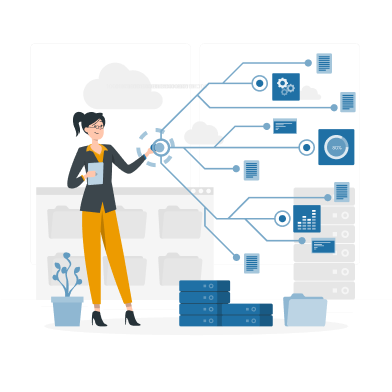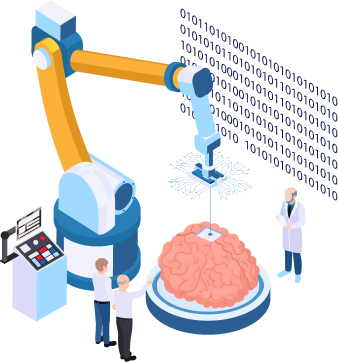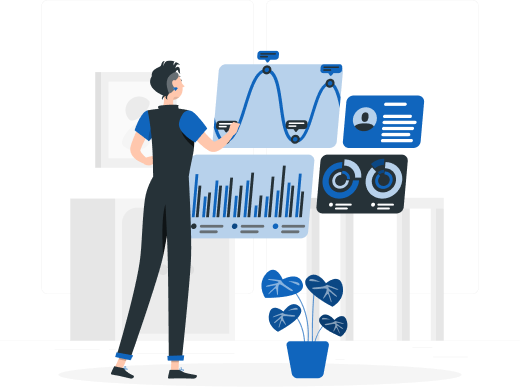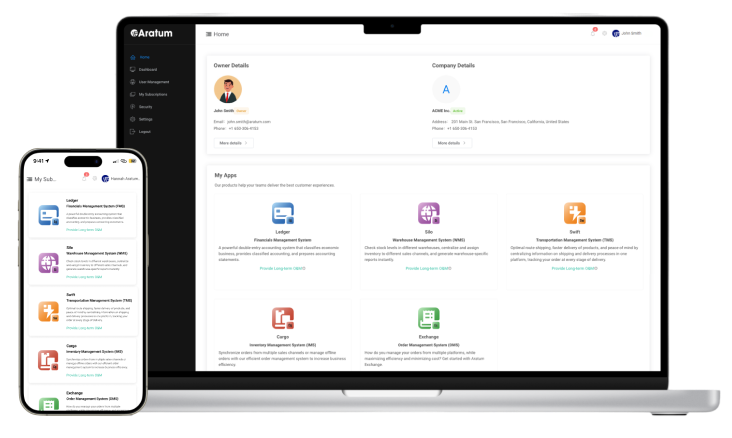In the complex world of supply chains, efficient management necessitates cutting-edge and robust technological solutions to advance product offerings and respond to the demands of partners and consumers.
With Aratum’s Analytics and BI infrastructure, your company can adapt to dynamic market conditions, improve customer satisfaction, and maintain a competitive edge in the industry.
Grow your business to new heights and be at the top of the game with Aratum’s robust and scalable AI technology and machine learning infrastructure.
Advanced Data Visualization
Data Integration
Machine Learning
Predictive Analytics
Real-time Monitoring
Cross-Functional Collaboration
Real-time Processing
Data Discovery and Warehousing
Advanced data visualization in business intelligence and analytics empower users to transform complex datasets into easily understandable visual representations, such as interactive charts, graphs, and heatmaps. By providing intuitive tools for exploration and analysis, advanced visualization enhances decision-making processes, facilitates data-driven insights, and enables stakeholders to grasp critical trends and patterns at a glance.

Data integration in analytics and business intelligence involves consolidating data from disparate sources into a unified platform or repository, ensuring consistency and accuracy. By breaking down data silos and enabling seamless access to information, businesses can derive meaningful insights and make informed decisions with confidence.

Machine learning in analytics involves leveraging algorithms and statistical models to analyze large datasets, identify patterns, and make predictions or recommendations without explicit programming instructions. By continuously learning from data, machine learning algorithms enable businesses to uncover hidden insights, optimize processes, and automate decision-making, leading to more efficient operations and competitive advantages.

Predictive analytics involves utilizing historical data, statistical algorithms, and machine learning techniques to forecast future outcomes, trends, and behaviors. By uncovering patterns and relationships within data, predictive analytics empowers businesses to anticipate changes, mitigate risks, identify opportunities, and make proactive decisions, ultimately driving strategic growth and competitive advantage.

Real-time monitoring in analytics enables businesses to track and analyze data as it occurs, providing immediate insights into operational performance, customer behavior, and market trends. By monitoring key metrics in real-time, organizations can identify issues, capitalize on opportunities, and make informed decisions swiftly, ensuring agility and responsiveness in today's dynamic business environment.

Real-time processing in analytics involves the immediate handling and analysis of data as it is generated or received, allowing for instantaneous insights and actions. By processing data in real-time, businesses can quickly respond to changing conditions, detect anomalies, and make timely decisions, enhancing operational efficiency and agility in dynamic environments.

Real-time processing in analytics involves the immediate handling and analysis of data as it is generated or received, allowing for instantaneous insights and actions. By processing data in real-time, businesses can quickly respond to changing conditions, detect anomalies, and make timely decisions, enhancing operational efficiency and agility in dynamic environments.

Data discovery and warehousing encompass identifying, exploring, and storing data for analysis and decision-making purposes. Data discovery involves locating and understanding relevant data sources, while data warehousing consists of organizing and storing data in a centralized repository for easy access and analysis. These processes enable businesses to manage their data assets efficiently, derive valuable insights, and drive informed decision-making.

Analytics and business intelligence are applied to improve patient outcomes by utilizing predictive analytics to forecast disease progression and identify personalized treatment plans, ultimately enhancing the quality and efficiency of care delivery.
Analytics and business intelligence enhance customer experience, optimize inventory, and boost sales by analyzing consumer behavior and market trends to personalize marketing, forecast demand, and optimize product assortment, driving revenue and profitability.
Analytics and business intelligence are employed to optimize inventory management, ensure regulatory compliance, and enhance medicine distribution efficiency by analyzing data on product demand, supply chain performance, and regulatory requirements. It improves patient access to medications while minimizing costs and risks.
Analytics and business intelligence analyze customer behavior to optimize marketing and personalize shopping experiences. Leveraging browsing patterns and purchase history data, organizations target the right audience, increase sales, and enhance satisfaction.
Analytics and business intelligence optimize route planning, fleet management, and operational efficiency by analyzing vehicle performance, traffic patterns, and customer demand. It minimizes costs, speeds up deliveries, and improves service reliability, boosting customer satisfaction and competitiveness.
AI technology and machine learning enhance production through predictive maintenance, quality control, and supply chain optimization. They analyze sensor data, reduce downtime and defects, improve efficiency, and lower costs for higher-quality products.
Analytics and business intelligence help in risk management, fraud detection, and investment decisions by analyzing market trends, customer behavior, and financial data to identify opportunities and mitigate risks, ensuring financial stability and profitability.
Analytics and business intelligence improve policy-making, service delivery, and resource allocation by analyzing demographic data and operational metrics. It drives evidence-based decision-making, fostering transparency, accountability, and citizen satisfaction.
Analytics and business intelligence streamline operations and enhance productivity by analyzing machine performance and supply chain data, driving cost savings and competitive advantage.
Analytics and business intelligence detect threats, identify vulnerabilities, and strengthen defense mechanisms by analyzing network traffic and user behavior. This proactive approach mitigates risks, safeguards data, and preserves organizational integrity.
Analytics and business intelligence help in risk management, fraud detection, and investment decisions by analyzing market trends, customer behavior, and financial data to identify opportunities and mitigate risks, ensuring financial stability and profitability.

Rise in Customer Base and Bank Product Investments
A mid-sized US bank was struggling with the management of their financial records. The sheer volume of transactions and manual data entry processes led to inefficiencies, errors, and compliance challenges. Retrieving specific records for audits or customer inquiries was time-consuming and prone to inaccuracies.
The bank turned to our solutions to streamline its operations in light of these challenges.
Analytics analyzes data to derive insights, patterns, and trends to inform decision-making and drive business strategy.
Business intelligence (BI) refers to the technologies, applications, and practices for collecting, integrating, analyzing, and presenting business data to support organizational decision-making.
While analytics focuses on analyzing data to uncover insights, BI encompasses the broader process of collecting, integrating, and presenting data to support organizational decision-making.
Analytics and business intelligence play a crucial role in supply chain management by providing insights into demand forecasting, inventory optimization, supplier performance, logistics efficiency, and overall supply chain visibility.
Analytics and BI help optimize logistics operations by analyzing transportation routes, delivery times, carrier performance, and warehouse efficiency. It allows organizations to minimize costs, improve delivery speed, and enhance overall supply chain performance.
Analytics and BI tools allow organizations to track and evaluate supplier performance based on quality, delivery times, pricing, and compliance, enabling better supplier selection, negotiation, and relationship management.
Analytics and BI enable organizations to optimize inventory levels by identifying patterns, trends, and seasonality in demand, reducing excess stock, minimizing stockouts, and improving overall inventory management efficiency.
Analytics and BI provide real-time insights into various aspects of the supply chain, including inventory levels, order status, production schedules, and shipment tracking. It enables organizations to proactively identify issues, mitigate risks, and make informed decisions. Data visualization in business intelligence and analytics makes it easy for managers and employees to check the insights.
Challenges may include data integration issues, poor data quality, lack of interoperability between systems, resistance to change, and the need for skilled personnel to interpret and act on insights effectively.
Emerging trends include the adoption of predictive analytics for proactive risk management, the integration of IoT (Internet of Things) devices for real-time data monitoring, the use of blockchain technology for enhanced transparency and traceability, and the application of AI and machine learning for more intelligent decision-making throughout the supply chain.

To implement Analytics and BI in your supply chain, you can rely on Aratum’s artificial intelligence services to help you get started and gain business visibility, efficiency, and resiliency.
Aratum is a globally recognized software provider specializing in developing supply chain management solutions. Our software solutions incorporate advanced algorithms and optimized data structures to facilitate efficient data processing and information dissemination across organizations.
Leveraging cutting-edge technologies such as machine learning and artificial intelligence, the software enables automated decision-making and real-time analytics, enhancing supply chain visibility and improving overall performance.
With a focus on delivering robust and scalable solutions, Aratum is committed to providing our clients with the tools necessary to optimize their supply chain operations and gain a competitive edge in your respective markets.












© 2024 Aratum or an Aratum affiliate company. All rights reserved. No part of this publication may be reproduced or transmitted in any form or for any purpose without the express permission of Aratum or an Aratum affiliate company. The information contained herein may be changed without prior notice. Some software products marketed by Aratum and its distributors contain proprietary software components of other software vendors. National product specifications may vary. These materials are provided by Aratum or an Aratum affiliate company for informational purposes only, without representation or warranty of any kind, and Aratum or its affiliated companies shall not be liable for errors or omissions with respect to the materials. The only warranties for Aratum or Aratum affiliate company products and services are those that are set forth in the express warranty statements accompanying such products and services, if any. Nothing herein should be construed as constituting an additional warranty. In particular, Aratum or its affiliated companies have no obligation to pursue any course of business outlined in this document or any related presentation, or to develop or release any functionality mentioned therein. This document, or any related presentation, and Aratum’s or its affiliated companies’ strategy and possible future developments, products, and/or platforms, directions, and functionality are all subject to change and may be changed by Aratum or its affiliated companies at any time for any reason without notice. The information in this document is not a commitment, promise, or legal obligation to deliver any material, code, or functionality. All forward-looking statements are subject to various risks and uncertainties that could cause actual results to differ materially from expectations. Readers are cautioned not to place undue reliance on these forward-looking statements, and they should not be relied upon in making purchasing decisions. Aratum and other Aratum products and services mentioned herein as well as their respective logos are trademarks or registered trademarks of Aratum (or an Aratum affiliate company) globally. All other product and service names mentioned are the trademarks of their respective companies. See aratum.com for additional trademark information and notices.